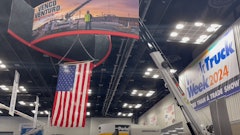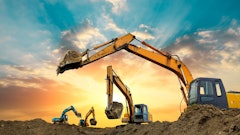
In the dynamic realm of construction, it's not just bricks and beams that hold everything together. Rigging and machines shape every project. These practices involve the intricate coordination between lifting, positioning and relocating heavy machinery and equipment.
Rigging in Construction
Rigging in construction is the precise act of raising, transporting and placing heavy machinery and equipment using many tools and methods. It holds a paramount significance in construction because it ensures the safety of workers and valuable assets, and it maintains the uninterrupted flow of projects. By distributing weight evenly, limiting accident risks and adhering to extreme safety protocols, rigging becomes a pillar for preventing costly delays and mishaps at construction sites.
Components of a Rigging System
In the world of manufacturing rigging, where the primary focus is on the precise maneuvering of machines and extremely large construction equipment, a distinct set of equipment becomes indispensable. The core components include an array of essential tools and machinery, each tailored to the specific needs. The mix includes:
- A 60,000-pound capacity forklift. This heavy-duty workhorse is instrumental in handling substantial loads, particularly heavy machines, with efficiency and safety.
- High-capacity electric forklifts. Paired with a combination of skates, these forklifts are vital for the delicate task of transporting and positioning heavy machines and construction equipment.
- Steel cables and wire ropes. These materials provide the unparalleled strength and resilience required for secure lifting and seamless relocation operations.
- Nylon or chain slings. Their versatility enables the handling of a wide range of loads and shapes with ease.
- Shackles and hooks. These vital connectors ensure a reliable link between different rigging components.
- Hoists and pulleys. These tools play a pivotal role in facilitating the precise lifting and positioning of heavy machines, a foundation of the rigging process.
- Cranes. On occasion, cranes become needed for their capability to handle heavy machinery and meet diverse rigging requirements.
- Load measuring instruments. The inclusion of these devices is crucial for ensuring precise weight management, a critical element for the safety and efficiency of rigging systems in specialized, manufacturing-focused rigging.
Different Rig Types
To assist in the rigging process, several rig types may be needed.
Crane Rigging
Crane rigging involves the precise lifting and positioning of heavy loads, making it a versatile method. Different types of cranes, such as mobile and tower cranes, are used for tasks. Crane rigging is especially effective for vertical material handling and requires skilled crane operators for safety and accuracy.
Forklift Rigging
Forklift rigging uses forklifts equipped with specialized attachments to lift and transport heavy items. This method is ideal for moving materials within confined spaces and is cost-effective for smaller-scale lifting tasks. Proper operator training is essential to ensure safe and efficient forklift rigging.
Tower Crane Rigging
Tower crane rigging is essential for tall construction projects, where precise vertical material handling is required. These cranes are securely fixed to the building's structure and possess high lifting capacity. Tower crane rigging is used for transporting heavy construction materials like steel, concrete and prefabricated components and demands skilled operators for accurate placement.
Mobile Crane Rigging
Mobile crane rigging employs versatile mobile cranes that can be easily transported to locations. These cranes are adaptable and well-suited for a wide range of construction environments.
They are frequently used for tasks like equipment placement and road construction. Competent crane operators are essential to securely manage loads during mobile crane rigging operations.
Rigging Safety Considerations & Planning
 Proper training and the right components help ensure safe and efficient rigging and transport.Sullivan Industrial Services
Proper training and the right components help ensure safe and efficient rigging and transport.Sullivan Industrial Services
Ensuring that personnel have the proper training and certification is paramount, equipping the team with the essential knowledge and skills for safe rigging practices. Regular equipment inspection and maintenance are required to guarantee that all tools and machinery are in their best working condition.
A Set Plan
Safety protocols during operation, such as "toolbox talks," facilitate transparent communication, hazard awareness and swift issue resolution. Alertness is also a critical factor. In an industry where accidents can happen in the blink of an eye, paying attention and being acutely aware of the task at hand and the surroundings are key. Fostering a culture of mutual support and hazard minimization to prevent near misses or accidents ensures the safety of the rigging team.
Innovations in Rigging & Machine Moving
Rigging and machine transportation continue to require innovations like new technology and modern materials for secure and efficient movement.
Technological Advancements
Rigging and machine moving have witnessed a transformation thanks to recent cutting-edge technology. Innovations like remote-controlled skates and advanced forklift designs have broadened the horizons of what's achievable in handling heavy loads, particularly in tight or difficult-to-access spaces. Yet, integrating these breakthroughs requires a learning curve as crews master these new tech tools to ensure operational safety.
Behind the scenes, the digital landscape is evolving too, now leveraging platforms that unify all aspects of project management, from the initial proposal to job completion, fostering seamless communication and collaboration among customers, project managers, office teams and onsite crews.
Automated Systems
Automation is taking center stage in rigging. Technologies like remote-controlled skates are automating heavy equipment movement, offering precision and control, especially in situations where space constraints challenge traditional equipment. However, adopting these automated systems necessitates comprehensive training to ensure they are used safely and effectively.
Modern Materials Enhancing Efficiency & Safety
In the realm of rigging, modern materials are revolutionizing efficiency and safety. Advanced alloys and synthetic ropes, lightweight yet incredibly durable, are replacing traditional rigging materials. These materials reduce overall equipment weight and elevate load-bearing capabilities. As a result, handling heavy loads becomes more efficient, and safety is significantly enhanced because of the reduced risk of accidents.
Innovation & Creativity Required
The world of rigging and machine moving within the construction space is an ever-evolving domain demanding a delicate blend of precision, safety and innovation. Whether it's the technological strides revolutionizing load handling or the introduction of modern materials for heightened efficiency and safety, rigging continually redefines its boundaries.
Rigging and transport require meticulous preparation, creative troubleshooting and a commitment to safety. Rigging extends beyond lifting. It is the art of overcoming challenges with skill and ingenuity, making it a cornerstone of successful construction projects.





























